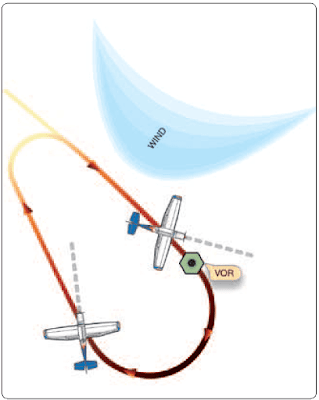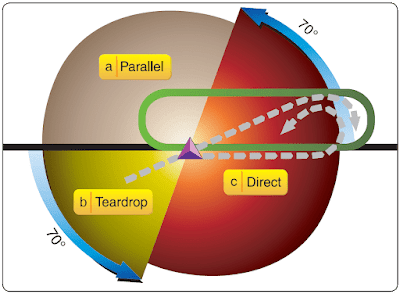Depending upon traffic and weather conditions, holding may be required. Holding is a predetermined maneuver that keeps aircraft within a specified airspace while awaiting further clearance from ATC. A standard holding pattern uses right turns, and a nonstandard holding pattern uses left turns. The ATC clearance always specifies left turns when a nonstandard pattern is to be flown.
Standard Holding Pattern (No Wind)
In a standard holding pattern with no winds [Figure 1], the aircraft follows the specified course inbound to the holding fix, turns 180° to the right, flies a parallel straight course outbound for 1 minute, turns 180° to the right, and flies the inbound course to the fix.
 |
| Figure 1. Standard holding pattern – no wind |
Standard Holding Pattern (With Wind)
A standard symmetrical holding pattern cannot be flown when winds exist. In those situations, the pilot is expected to:
- Compensate for the effect of a known wind except when turning.
- Adjust outbound timing to achieve a 1-minute (11⁄2 minutes above 14,000 feet) inbound leg.
 |
| Figure 2. Drift correction in holding pattern |
Holding Instructions
If an aircraft arrives at a clearance limit before receiving clearance beyond the fix, ATC expects the pilot to maintain the last assigned altitude and begin holding in accordance with the charted holding pattern. If no holding pattern is charted and holding instructions have not been issued, enter a standard holding pattern on the course on which the aircraft approached the fix and request further clearance as soon as possible. Normally, when no delay is anticipated, ATC issues holding instructions at least 5 minutes before the estimated arrival at the fix. Where a holding pattern is not charted, the ATC clearance specifies the following:
- Direction of holding from the fix in terms of the eight cardinal compass points (N, NE, E, SE, etc.)
- Holding fix (the fix may be omitted if included at the beginning of the transmission as the clearance limit)
- Radial, course, bearing, airway, or route on which the aircraft is to hold.
- Leg length in miles if DME or RNAV is to be used (leg length is specified in minutes on pilot request or if the controller considers it necessary).
- Direction of turn, if left turns are to be made, because the pilot requests or the controller considers it necessary.
- Time to expect-further-clearance (EFC) and any pertinent additional delay information.
ATC instructions are also issued whenever:
- It is determined that a delay will exceed 1 hour.
- A revised EFC is necessary.
- In a terminal area having a number of NAVAIDs and approach procedures, a clearance limit may not indicate clearly which approach procedures will be used. On initial contact, or as soon as possible thereafter, approach control advises the pilot of the type of approach to expect.
- Ceiling and/or visibility is reported as being at or below the highest “circling minimums” established for the airport concerned. ATC transmits a report of current weather conditions and subsequent changes, as necessary.
- An aircraft is holding while awaiting approach clearance, and the pilot advises ATC that reported weather conditions are below minimums applicable to the operation. In this event, ATC issues suitable instructions to aircraft desiring either to continue holding while awaiting weather improvement or proceed to another airport.
Standard Entry Procedures
The entry procedures given in the AIM evolved from extensive experimentation under a wide range of operational conditions. The standardized procedures should be followed to ensure that an aircraft remains within the boundaries of the prescribed holding airspace.
When a speed reduction is required, start the reduction when 3 minutes or less from the holding fix. Cross the holding fix initially at or below the maximum holding airspeed (MHA). The purpose of the speed reduction is to prevent overshooting the holding airspace limits, especially at locations where adjacent holding patterns are close together.
All aircraft may hold at the following altitudes and maximum holding airspeeds:
| Altitude Mean Sea Level (MSL) | Airspeed (KIAS) |
|---|---|
| Up to 6,000 feet | 200 |
| 6,001 – 14,000 feet | 230 |
| 14,001 feet and above | 265 |
- Holding patterns from 6,001 to 14,000 feet may be restricted to a maximum airspeed of 210 knots indicated airspeed (KIAS). This nonstandard pattern is depicted by an icon.
- Holding patterns may be restricted to a maximum airspeed of 175 KIAS. This nonstandard pattern is depicted by an icon. Holding patterns restricted to 175 KIAS are generally found on IAPs applicable to category A and B aircraft only.
- Holding patterns at Air Force airfields only—310 KIAS maximum, unless otherwise depicted.
- Holding patterns at Navy airfields only—230 KIAS maximum, unless otherwise depicted.
- The pilot of an aircraft unable to comply with maximum airspeed restrictions should notify ATC.
While other entry procedures may enable the aircraft to enter the holding pattern and remain within protected airspace, the parallel, teardrop, and direct entries are the procedures for entry and holding recommended by the FAA. Additionally, paragraph 5-3-7 in the AIM should be reviewed. [Figure 3]
 |
| Figure 3. Holding pattern entry procedures |
- Parallel Procedure. When approaching the holding fix from anywhere in sector (a), fly to the fix. Afterwards, turn to a heading to parallel the holding course outbound. Fly outbound for 1 minute, turn in the direction of the holding pattern through more than 180°, and return to the holding fix or intercept the holding course inbound.
- Teardrop Procedure. When approaching the holding fix from anywhere in sector (b), the teardrop entry procedure would be to fly to the fix, turn outbound to a heading for a 30° teardrop entry within the pattern (on the holding side) for a period of 1 minute, then turn in the direction of the holding pattern to intercept the inbound holding course.
- Direct Entry Procedure. When approaching the holding fix from anywhere in sector (c), the direct entry procedure would be to fly directly to the fix and turn to follow the holding pattern.
- 3° per second, or
- 30° bank angle, or
- A bank angle provided by a flight director system.
Time Factors
The holding pattern entry time reported to ATC is the initial time of arrival over the fix. Upon entering a holding pattern, the initial outbound leg is flown for 1 minute at or below 14,000 feet MSL, and for 11⁄2 minutes above 14,000 feet MSL. Timing for subsequent outbound legs should be adjusted as necessary to achieve proper inbound leg time. The pilot should begin outbound timing over or abeam the fix, whichever occurs later. If the abeam position cannot be determined, start timing when the turn to outbound is completed. [Figure 4]
 |
| Figure 4. Holding-outbound timing |
Time leaving the holding fix must be known to ATC before succeeding aircraft can be cleared to the vacated airspace. Leave the holding fix:
- When ATC issues either further clearance en route or approach clearance;
- As prescribed in 14 CFR part 91 (for IFR operations; two-way radio communications failure, and responsibility and authority of the pilot-in-command); or
- After the IFR flight plan has been cancelled, if the aircraft is holding in VFR conditions.
DME Holding
The same entry and holding procedures apply to DME holding, but distances (nautical miles) are used instead of time values. The length of the outbound leg is specified by the controller, and the end of this leg is determined by the DME readout.
